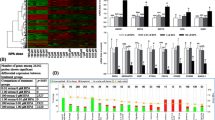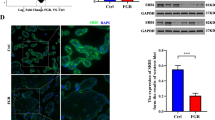Abstract
We previously demonstrated that prenatal exposure to Bisphenol A (BPA) disrupts fetal lung maturation likely through the glucocorticoid signalling pathway, but the precise molecular mechanisms remain obscure. Given that BPA diminished the expression of epithelial sodium channel-γ (ENaCγ), a well-known glucocorticoid receptor (GR) target gene, in fetal lungs, we used this GR target gene to delineate the molecular pathway through which BPA exerts its effects on lung cells. The A549 lung epithelial cell line was used as an in vitro model system. As a first step, we validated our in vitro cell model by demonstrating a robust concentration-dependent suppression of ENaCγ expression following BPA exposure. We also showed that both dexamethasone and siRNA-mediated knockdown of GR expression blocked/abrogated the inhibitory effects of BPA on ENaCγ expression, suggesting that BPA repressed ENaCγ expression via inhibition of GR activity. Given the well-known antagonistic interactions between the pro-inflammatory transcriptional factor NF-κB and GR, we then showed that BPA inhibited GR activity through the activation of NF-κB. Lastly, since BPA is known to function as a pro-inflammatory factor via the estrogen receptor β (ERβ), we provided evidence that BPA signals through ERβ to activate the NF-κB signalling pathway. Taken together, these findings demonstrate that BPA acts on ERβ to activate the NF-κB signalling pathway, which in turn leads to diminished GR activity and consequent repression of ENaCγ expression in lung epithelial cells. Thus, our present study reveals a novel BPA signalling pathway that involves ERβ, NF-κB and GR.







Similar content being viewed by others
References
Adcock I, Caramori G, Ito K (2006) New insights into the molecular mechanisms of corticosteroids actions. Curr Drug Targets 7:649–660
Alonso-Magdalena P, Ropero AB, Soriano S et al (2012) Bisphenol-A acts as a potent estrogen via non-classical estrogen triggered pathways. Mol Cell Endocrinol 355:201–207
Baeuerle PA, Henkel T (1994) Function and activation of NF-kappa B in the immune system. Annu Rev Immunol 12:141–179
Beg AA, Sha WC, Bronson RT, Baltimore D (1995) Constitutive NF-kappa B activation, enhanced granulopoiesis, and neonatal lethality in I kappa B alpha-deficient mice. Genes Dev 9:2736–2746
Ben Y, Chen J, Zhu R et al (2008) Upregulation of AQP3 and AQP5 induced by dexamethasone and ambroxol in A549 cells. Respir Physiol Neurobiol 161:111–118
Cabannes E, Khan G, Aillet F et al (1999) Mutations in the IkBa gene in Hodgkin’s disease suggest a tumour suppressor role for IkappaBalpha. Oncogene 18:3063–3070
Caldenhoven E, Liden J, Wissink S et al (1995) Negative cross talk between RelA and the glucocorticoid receptor: a possible mechanism for the antiinflammatory action of glucocorticoid. Mol Endocrinol 9:401–412
Calhoun KC, Padilla-Banks E, Jefferson WN et al (2014) Bisphenol A exposure alters developmental gene expression in the fetal rhesus macaque uterus. PLoS ONE 9:e85894
Chapalamadugu KC, VandeVoort CA, Settles ML et al (2014) Maternal Bisphenol A exposure impacts the fetal heart transcriptome. PLoS ONE 9:e89096
Cole TJ, Solomon NM, Van Driel R et al (2004) Altered epithelial cell proportions in the fetal lung of glucocorticoid receptor null mice. Am J Respir Cell Mol Biol 30:613–619
De Coster S, Van Larebeke N (2012) Endocrine-disrupting chemicals: associated disorders and mechanisms of action. J Environ Public Health 2012:713696
DeBenedictis B, Guan H, Yang K (2016) Prenatal exposure to Bisphenol A disrupts mouse fetal liver maturation in a sex-specific manner. J Cell Biochem 117:344–350
Dittmar KD, Pratt WB (1997) Folding of the glucocorticoid receptor by the reconstituted Hsp90-based chaperone machinery. The initial hsp90.p60.hsp70-dependent step is sufficient for creating the steroid binding conformation. J Biol Chem 272:13047–13054
Donohue KM, Miller RL, Perzanowski MS et al (2013) Prenatal and postnatal Bisphenol A exposure and asthma development among inner-city children. J Allergy Clin Immunol 131:736–742
Doucas V, Shi Y, Miyamoto S et al (2000) Cytoplasmic catalytic subunit of protein kinase A mediates cross-repression by NF-kappa B and the glucocorticoid receptor. Proc Natl Acad Sci USA 97:11893–11898
Elsworth JD, Jentsch JD, VandeVoort CA et al (2013) Prenatal exposure to Bisphenol A impacts midbrain dopamine neurons and hippocampal spine synapses in non-human primates. Neurotoxicology 35:113–120
Erden ES, Motor S, Ustun I et al (2014) Investigation of Bisphenol A as an endocrine disruptor, total thiol, malondialdehyde, and C-reactive protein levels in chronic obstructive pulmonary disease. Eur Rev Med Pharmacol Sci 18:3477–3483
Geens T, Aerts D, Berthot C et al (2012) A review of dietary and non-dietary exposure to Bisphenol-A. Food Chem Toxicol 50:3725–3740
Grier DG, Halliday HL (2004) Effects of glucocorticoids on fetal and neonatal lung development. Treat Respir Med 3:295–306
Guan H, Sun K, Yang K (2013) The ERK1/2 signaling pathway regulates 11beta-hydroxysteroid dehydrogenase type 2 expression in human trophoblast cells through a transcriptional mechanism. Biol Reprod 89:92
Hayden MS, Ghosh S (2004) Signaling to NF-kappaB. Genes Dev 18:2195–2224
Hijazi A, Guan H, Cernea M, Yang K (2015) Prenatal exposure to Bisphenol A disrupts mouse fetal lung development. FASEB J 29:4968–4977
Hummler E, Horisberger JD, Armanini D et al (1999) Genetic disorders of membrane transport. V. The epithelial sodium channel and its implication in human diseases. Am J Physiol 276:G567–G571
Itani OA, Auerbach SD, Husted RF et al (2002) Glucocorticoid-stimulated lung epithelial Na(+) transport is associated with regulated ENaC and sgk1 expression. Am J Physiol Lung Cell Mol Physiol 282:L631–L641
Kim K-N, Kim JH, Kwon H-J et al (2014) Bisphenol A exposure and asthma development in school-age children: a longitudinal study. PLoS ONE 9:e111383
Lazrak A, Samanta A, Venetsanou K et al (2000) Modification of biophysical properties of lung epithelial Na(+) channels by dexamethasone. Am J Physiol Cell Physiol 279:C762–C770
Lee S, Suk K, Kim IK et al (2008) Signaling pathways of Bisphenol A-induced apoptosis in hippocampal neuronal cells: role of calcium-induced reactive oxygen species, mitogen-activated protein kinases, and nuclear factor-kappaB. J Neurosci Res 86:2932–2942
Liggins GC (1994) The role of cortisol in preparing the fetus for birth. Reprod Fertil Dev 6:141–150
Liu Y, Mei C, Liu H et al (2014) Modulation of cytokine expression in human macrophages by endocrine-disrupting chemical Bisphenol-A. Biochem Biophys Res Commun 451:592–598
Lu Z, Gu Y, Rooney SA (2001) Transcriptional regulation of the lung fatty acid synthase gene by glucocorticoid, thyroid hormone and transforming growth factor-β1. Biochim Biophys Acta 1532:213–222
Ma XF, Zhang J, Shuai HL et al (2015) IKKβ/NF-κB mediated the low doses of Bisphenol A induced migration of cervical cancer cells. Arch Biochem Biophys 573:52–58
McKay LI, Cidlowski JA (1998) Cross-talk between nuclear factor-kappa B and the steroid hormone receptors: mechanisms of mutual antagonism. Mol Endocrinol 12:45–56
Medwid S, Guan H, Yang K (2016) Prenatal exposure to Bisphenol A disrupts adrenal steroidogenesis in adult mouse offspring. Environ Toxicol Pharmacol 43:203–208
Michałowicz J (2014) Bisphenol A: sources, toxicity and biotransformation. Environ Toxicol Pharmacol 37:738–758
Nakajima Y, Goldblum RM, Midoro-Horiuti T (2012) Fetal exposure to Bisphenol A as a risk factor for the development of childhood asthma: an animal model study. Environ Health 11:8
Padmanabhan V, Siefert K, Ransom S et al (2008) Maternal Bisphenol-A levels at delivery: a looming problem? J Perinatol 28:258–263
Peretz J, Vrooman L, Ricke WA et al (2014) Bisphenol A and reproductive health: update of experimental and human evidence, 2007–2013. Environ Health Perspect 122:775–786
Picard D, Khursheed B, Garabedian MJ et al (1990) Reduced levels of hsp90 compromise steroid receptor action in vivo. Nature 348:166–168
Qi S, Fu W, Wang C et al (2014) BPA-induced apoptosis of rat Sertoli cells through Fas/FasL and JNKs/p38 MAPK pathways. Reprod Toxicol 50:108–116
Rajakumar C, Guan H, Langlois D et al (2015) Bisphenol A disrupts gene expression in human placental trophoblast cells. Reprod Toxicol 53:39–44
Rajapandi T, Greene LE, Eisenberg E (2000) The molecular chaperones Hsp90 and Hsc70 are both necessary and sufficient to activate hormone binding by glucocorticoid receptor. J Biol Chem 275:22597–22604
Ray A, Prefontaine KE (1994) Physical association and functional antagonism between the p65 subunit of transcription factor NF-kappa B and the glucocorticoid receptor. Proc Natl Acad Sci USA 91:752–756
Reichardt H, Tronche F, Berger S et al (2000) New insights into glucocorticoid and mineralocorticoid signaling: lessons from gene targeting. Adv Pharmacol 47:1–21
Rochester JR (2013) Bisphenol A and human health: a review of the literature. Reprod Toxicol 42:132–155
Roelofs MJE, van den Berg M, Bovee TFH et al (2015) Structural bisphenol analogues differentially target steroidogenesis in murine MA-10 Leydig cells as well as the glucocorticoid receptor. Toxicology 329:10–20
Scheinman RI, Gualberto A, Jewell CM et al (1995) Characterization of mechanisms involved in transrepression of NF-kB by activated glucocorticoid receptors. Mol Cell Biol 15:943–953
Schug TT, Janesick A, Blumberg B, Heindel JJ (2012) Endocrine disrupting chemicals and disease susceptibility. J Steroid Biochem Mol Biol 127:204–215
Spanier AJ, Kahn RS, Kunselman AR et al (2012) Prenatal exposure to Bisphenol A and child wheeze from birth to 3 years of age. Environ Health Perspect 120:916–920
Spanier AJ, Fiorino EK, Trasande L (2014a) Bisphenol A exposure is associated with decreased lung function. J Pediatr 164(1403–8):e1
Spanier AJ, Kahn RS, Kunselman AR et al (2014b) Bisphenol A exposure and the development of wheeze and lung function in children through age 5 years. JAMA Pediatr 168:1131–1137
Stewart A, Guan H, Yang K (2010) BMP-3 promotes mesenchymal stem cell proliferation through the TGF-beta/activin signaling pathway. J Cell Physiol 223:658–666
Susiarjo M, Hassold TJ, Freeman E, Hunt PA (2007) Bisphenol A exposure in utero disrupts early oogenesis in the mouse. PLoS Genet 3:63–70
Tabb MM, Blumberg B (2006) New modes of action for endocrine-disrupting chemicals. Mol Endocrinol 20:475–482
Tharp AP, Maffini MV, Hunt PA et al (2012) Bisphenol A alters the development of the rhesus monkey mammary gland. Proc Natl Acad Sci USA 109:8190–8195
Valentino R, D’Esposito V, Passaretti F et al (2013) Bisphenol-A impairs insulin action and up-regulates inflammatory pathways in human subcutaneous adipocytes and 3T3-L1 cells. PLoS ONE 8:1–10
Vandenberg LN, Hauser R, Marcus M et al (2007) Human exposure to Bisphenol A (BPA). Reprod Toxicol 24:139–177
Veiga-Lopez A, Luense LJ, Christenson LK, Padmanabhan V (2013) Developmental programming: gestational Bisphenol-A treatment alters trajectory of fetal ovarian gene expression. Endocrinology 154:1873–1884
Wadia PR, Cabaton NJ, Borrero MD et al (2013) Low-dose BPA exposure alters the mesenchymal and epithelial transcriptomes of the mouse fetal mammary gland. PLoS ONE 8:e63902
Wang KC, Lin YF, Qin CH et al (2010) Bisphenol-A interferes with estradiol-mediated protection in osteoarthritic chondrocytes. Toxicol Lett 198:127–133
Welshons WV, Nagel SC, vom Saal FS (2006) Large effects from small exposures. III. Endocrine mechanisms mediating effects of Bisphenol A at levels of human exposure. Endocrinology 147:S56–S69
Whitehead R, Guan H, Arany E et al (2016) Prenatal exposure to Bisphenol A alters mouse fetal pancreatic morphology and islet composition. Horm Mol Biol Clin Investig 25:171–179
Wolstenholme JT, Edwards M, Shetty SRJ et al (2012) Gestational exposure to Bisphenol A produces transgenerational changes in behaviors and gene expression. Endocrinology 153:3828–3838
Yang M, Qiu W, Chen B et al (2015) The in vitro immune modulatory effect of Bisphenol A on fish macrophages via estrogen receptor α and nuclear factor-κB signaling. Environ Sci Technol 49:1888–1895
Zhu J, Jiang L, Liu Y et al (2015) MAPK and NF-κB pathways are involved in Bisphenol A-induced TNF-α and IL-6 production in BV2 microglial cells. Inflammation 38:637–648
Author information
Authors and Affiliations
Corresponding author
Electronic supplementary material
Below is the link to the electronic supplementary material.
Rights and permissions
About this article
Cite this article
Hijazi, A., Guan, H. & Yang, K. Bisphenol A suppresses glucocorticoid target gene (ENaCγ) expression via a novel ERβ/NF-κB/GR signalling pathway in lung epithelial cells. Arch Toxicol 91, 1727–1737 (2017). https://doi.org/10.1007/s00204-016-1807-7
Received:
Accepted:
Published:
Issue Date:
DOI: https://doi.org/10.1007/s00204-016-1807-7




